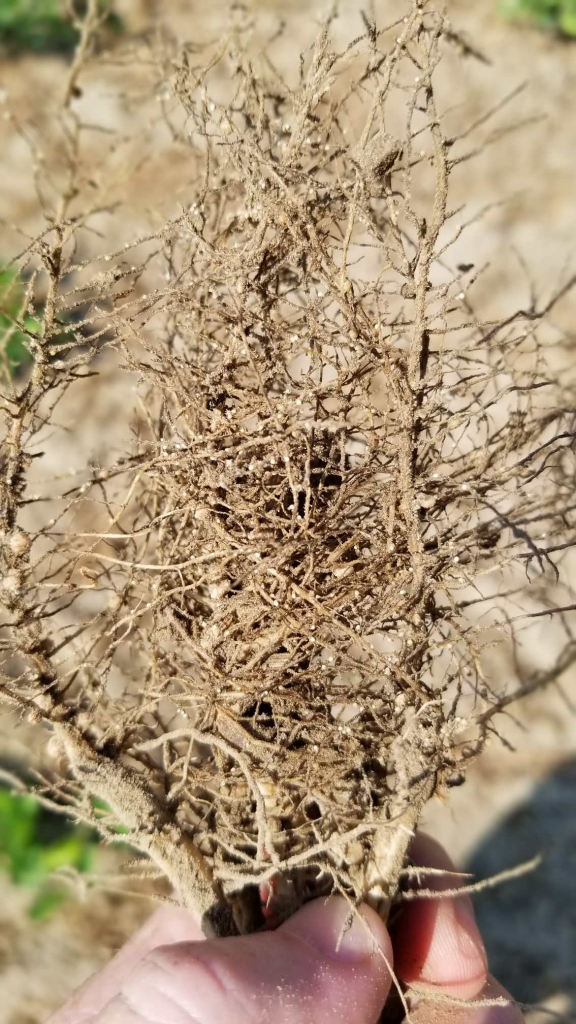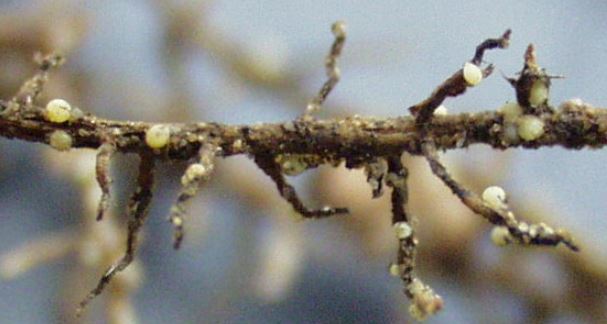Soybean Cyst Nematode (Heterodera glycines)
Although soybeans are the major host, soybean cyst nematode (SCN) has a wide range of hosts that includes dry edible beans. SCN has been increasing in edible bean-producing areas of the province. Planting dry edible beans into SCN-infested fields can result in an increase in root rot complex infection, since the nematode damages the roots, allowing for easier access by these organisms.
Incidence
Since it was first identified in Ontario in 1988, soybean cyst nematode (SCN) has been identified in most counties west of Toronto, and more recently in central and eastern Ontario as well as Quebec. Unfortunately, SCN will continue to move across the province into previously non-infested counties. Recent surveys in southwestern Ontario found 80% of the soybean fields tested were positive for SCN. All dry bean producers should scout and test for SCN.
Once SCN is in a field, eradication is impossible. Losses to SCN in Ontario soybeans have ranged from 5%–100%. Yield losses in dry edible beans are not well defined but are known to be dependant on the market class.
- Aduzki beans are the most susceptible to SCN, more so than susceptible soybean varieties, and should not be grown on infected fields
- Kidney and cranberry beans show similar or slightly less SCN reproduction compared to susceptible soybeans
- White (navy) beans generally display less SCN reproduction than susceptible soybeans, but they are not resistant and there can be large differences between varieties
- Black beans appear to be the most tolerant to SCN compared to other dry beans, and are generally much more tolerant than SCN susceptible soybeans. However, multiple black bean varieties have not been studied.
- other types of dry beans, such as otebo, have not been tested locally
Appearance
These microscopic, worm-like nematodes damage the root system and prevent the uptake of water and nutrients. In many cases SCN symptoms may not be obvious in a field until populations build significantly. SCN symptoms in dry beans will be similar to symptoms in soybeans. Stunting, poor canopy closure, and chlorosis may be evident. Plants may have fewer pods or mature early, and damage may show up earlier in sandy areas. Often there are no above ground symptoms at all. Damage often occurs in circles and is confused or misdiagnosed as nutrient deficiency, flooding, herbicide injury, compaction, drought or root rot damage. Yellowing of the leaf margins can resemble potassium deficiency symptoms, however, the addition of potassium will not reduce the damage from SCN or eliminate symptoms.
Below-ground SCN symptoms include dwarfed, stunted and discoloured roots (due to root rot pathogens) with less nitrogen-fixing nodules. However, the most obvious sign of SCN infection is the presence of the adult female “cysts” on the roots, which are white to yellow-brown pin-head cysts less than 1 mm in diameter. Never pull up a plant to check for SCN, since too much root will be lost and the nematodes will be stripped of. Instead, use a shovel and dig up the plant along with the soil surrounding the roots.
SCN infection symptoms may not be obvious, and yield reductions of 25%–30% on susceptible soybean fields can occur without visual (above-ground) symptoms. Yield losses in dry beans are not well defined, and susceptibility depends on the market class of bean.
Areas of the field where above-ground SCN symptoms will most often occur include entrance points for equipment into the feld, equipment and vehicle storage areas, tops of knolls, compacted headlands, and along the fencerow where wind-blown soil tends to accumulate.
Disease Cycle
The life cycle of SCN has three major stages: egg, juvenile and adult. The cycle begins when eggs hatch to release worm-shaped juveniles in the soil. This is the only stage when SCN can infect roots. Once they have penetrated the roots, the young nematodes migrate to the water and nutrient-conducting tissue (vascular system) and establish a feeding site (syncytia). At this stage, the female nematode begins to swell and eventually breaks through the root surface. Adult females that remain attached to the root to feed, produce eggs in a mass or egg sac outside of the body. As the life cycle nears completion, eggs also develop within the female’s body cavity called “cysts”. Initially white, the cysts turn yellow and brown as females mature. Each cyst can contain 100–300 eggs. The number of cysts per plant varies from a few to many hundreds. In infected soil, cysts are distributed throughout the root zone and can survive for 10 or more years. The entire life cycle takes approximately 4 weeks when soil temperatures are 25°C, or up to five or more weeks at cooler temperatures.
Management Strategies
There are currently no SCN resistant dry bean varieties available, although US researchers have begun breeding for resistance. There are also no foliar or seed treatment products registered in dry beans for SCN management.
The following practices will decrease the likelihood of this pest causing significant economic losses:
- Plant certified or good-quality, clean seed that is free of soil
- Wash soil of farm equipment when moving it between infested fields or farms.
- Use proper soil conservation practices to reduce soil movement between fields.
- Practice prudent weed control. Many weeds, particularly annual weeds such as purple deadnettle, henbit and field pennycress, may serve as hosts to SCN.
- Establish a rotation with non-host crops such as corn, wheat, alfalfa, oats, vegetable crops like tomatoes and some cover crops, which benefit by reducing SCN populations and improving yields.
- Monitor SCN population in the soil by soil sampling every 3–6 years. . Use a soil probe to take samples at a depth of 6-8 inches. Sample directly in the row, before tillage is conducted. The first time a field is checked for SCN, sample areas where SCN is likely to establish first including near the field entrance, along fence lines, areas that have been flooded, and areas of high soil pH (greater than 7). Send samples for nematode analysis to an accredited laboratory. Ask for both an egg count and a total cyst count.

